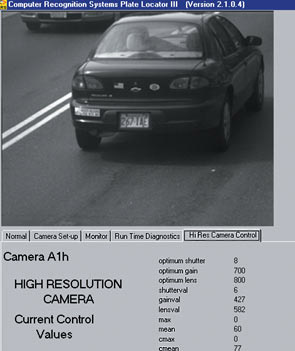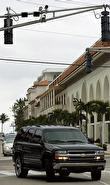
"[This technology] subjects every citizen and visitor to a state police check without probable cause or even any basis for suspicion." -- Howard Simon, Executive Director, Florida Civil Liberties Union, quoted by the Associated Press, 30 April 2004.

License-plate recognition is a function of highly specialized software programs that allow computers to 1) take photographs of automobile traffic provided by video surveillance cameras, 2) focus upon the license plate of each and every vehicle that's been photographed, 3) "read" and record the series of numbers and/or letters imprinted on the plate, and 4) check to see if and how this information is contained in the (various) database(s). Such checks 5) can identify plates/cars/drivers who have arrest warrants, expired registrations, or cars reported as stolen, 6) can bill ordinary, law-abiding citizens for their use of highways or border-crossings, 7) can be done in a matter of seconds, and can be done (again) when another camera is encountered, which 8) allows the (various) database(s) to keep track of the movements, destinations, and speeds of plates/cars/drivers who have been identified (i.e., all of them).
Unlike face recognition software, which, when used upon large crowds of people in public places, has unacceptably high error and false-positive rates, license-plate recognition makes comparatively few mistakes. License plates, unlike human faces, are always precisely where you expect them to be, two-dimensional, easy to photograph and "scan," and full of already encoded ("machine-readable") information.
Significantly, license-plate recognition is far more privacy-invasive than face recognition software. A face may be "recognized" -- its features may be discerned, recorded and measured -- but that is all. It isn't "read" or analyzed (for example: submitted to medical, anthropological or phrenological study). But a license plate can be "read" and made to reveal all the confidential information it contains (name, age, physical description, address, type of vehicle, driving record, etc). In short, unlike a face, a license plate can be -- is being -- turned into a bar code.

Precisely because it has pioneered the use of large numbers of surveillance cameras installed in public places (street-intersections, the sides of buildings, poles erected in public areas, train stations, et al.), England makes the most extensive use of license-plate recognition. The "function creep" in London is especially striking: what started out as a system designed to prevent IRA car-bombers from entering and destroying the City has -- quickly but gradually -- been turned into a system by which ordinary citizens are charged "road-usage fees." Not only does such a "creep" generalize suspicion and (irrationally) include law-abiding citizens in the same category as the IRA, it also forces the taxpayers to pay for the surveillance system twice: they paid for it when it was originally installed, back in the mid-1990s, and now they're paying for it again, in piecemeal fashion, every time the system's function is creeped from anti-terrorism to toll collection. Were it not for the existence of the anti-terrorist surveillance system, the very idea of "road-usage fees" would never have been approved, let alone enforced by fully automated, computerized devices.

License-plate recognition software is widely used in Italy and Switzerland, and used on an experimental basis in Manalapan, Florida, USA.
By e-mail SCP@notbored.org
By snail mail: SCP c/o NOT BORED! POB 1115, Stuyvesant Station, New York City 10009-9998